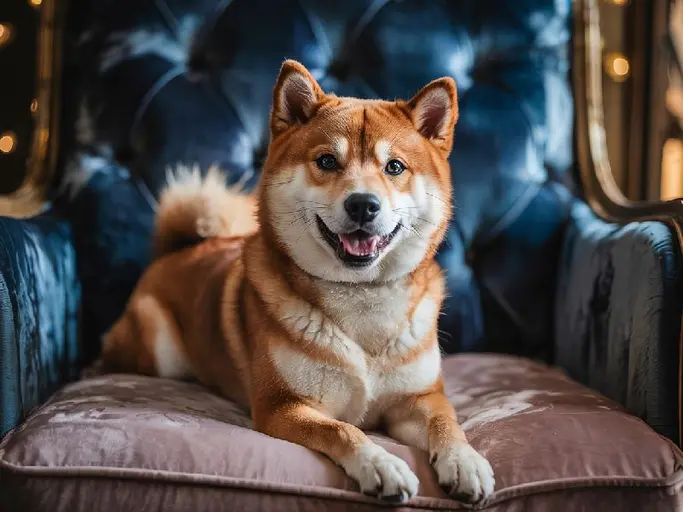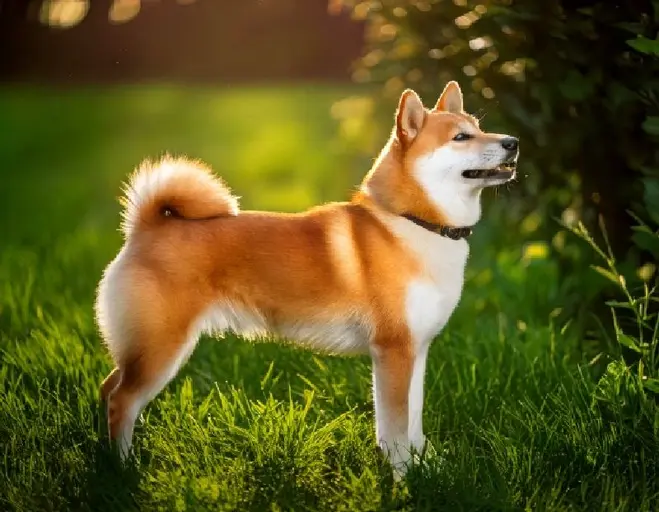Unlocking the Secrets of the Shiba Inu: A Comprehensive Guide

Brief Introduction
The Shiba Inu, a Japanese Spitz breed, is a small but sturdy dog known for its alert personality, independent spirit, and fox-like appearance. Their curled tail, erect triangular ears, and confident gait make them instantly recognizable. Originating from Japan, they were initially bred for hunting small game and flushing out birds, but today, they are cherished companions around the world. What truly sets the Shiba Inu apart is their captivating charm and unwavering self-assuredness. This breed is known for its unique personality and its tendency to behave almost like a cat, making them a fascinating addition to any home.
Breed History
Origins in Japan
The history of the Shiba Inu is deeply rooted in ancient Japan. Believed to be one of the oldest Japanese dog breeds, their lineage can be traced back thousands of years. The Shiba Inu comes from one of the six native Spitz breeds of Japan: Akita, Kishu, Hokkaido, Kai Ken, Shikoku, and Shiba Inu. Initially, there were three main regional Shiba Inu types, each named after the area where they originated: the Shinshu Shiba, Mino Shiba, and Sanin Shiba.
Role in the Past
Historically, Shiba Inus were bred for hunting small game in the mountainous regions of Japan. They were adept at flushing out birds and tracking smaller animals such as wild boar. Their compact size and agility made them well-suited for navigating the dense undergrowth. Often, they would work as solo hunters or in pairs, exhibiting a strong sense of independence and resourcefulness. They proved to be skilled and essential hunting companions.
Formation of the Breed
Following World War II, the Shiba Inu breed faced near extinction due to disease and food shortages. However, dedicated breeders worked to preserve and rebuild the breed by combining the remaining bloodlines from the three regional types. The modern Shiba Inu we know today is a result of this careful reconstruction effort. The breed was recognized by the Japanese Kennel Club (JKC) in 1934 and later by the American Kennel Club (AKC) in 1992.
Appearance
Height and Weight
Shiba Inus are considered a small to medium-sized breed. Males typically stand between 14.5 and 16.5 inches tall at the shoulder, while females range from 13.5 to 15.5 inches. Their weight usually falls between 17 and 23 pounds, depending on their build and gender.
Coat
The Shiba Inu boasts a double coat, which provides excellent insulation and protection from the elements. The outer coat is stiff and straight, while the undercoat is soft and dense. This combination helps them regulate their body temperature in both hot and cold weather. Common coat colors include red, black and tan, sesame (a mix of red and black hairs), and cream. The Urajiro markings, white markings on the muzzle, cheeks, throat, chest, and underbelly, are a distinctive feature of the breed and are considered desirable.
Ears
A defining characteristic of the Shiba Inu is their erect, triangular ears. These ears are relatively small and slightly rounded at the tips, giving them an alert and inquisitive expression. They are always held firmly upright.
Eyes
Their eyes are dark brown, relatively small, and triangular in shape. The eyes are set well apart and give the Shiba Inu an intelligent and often mischievous expression. The proper eye shape and placement contribute significantly to the breed’s characteristic “fox-like” appearance.
Tail
The tail of the Shiba Inu is another hallmark of the breed. It is typically curled tightly over the back, although it can also be carried in a sickle-shaped curve. The length of the tail is proportionate to the body, and it is well-furred. The tail carriage adds to the overall balance and elegance of the dog’s silhouette.
Other Characteristic Features
Besides what was mentioned above, one more characteristic is the compact build. The Shiba Inu has a well-muscled and compact body, giving them a strong and agile appearance. Their proportions are balanced, and they move with a confident and graceful gait.
Character and Behavior
Attitude Towards People
Shiba Inus are known for their independent and somewhat aloof nature. While they can be affectionate with their family members, they often don’t shower them with constant attention. They are not typically “cuddly” dogs. Instead, they prefer to maintain a sense of personal space and independence. Early socialization is crucial to ensure they are comfortable around strangers.
Attitude Towards Children
Shiba Inus can be good with children, especially if they are raised together from a young age. However, it’s important to teach children how to interact respectfully with the dog. Shibas do not tolerate being teased or handled roughly, and they may react defensively if they feel threatened. Supervision is always recommended when young children and Shibas are interacting.
Attitude Towards Other Animals
Shiba Inus can be territorial, especially towards other dogs of the same sex. Early and consistent socialization is essential to help them learn to accept other animals. They may have a strong prey drive, so caution should be exercised when introducing them to smaller pets such as cats or rabbits. Supervision is crucial, especially in the beginning.
Activity Level
Shiba Inus have a moderate energy level. They require daily exercise to stay physically and mentally stimulated. This can include walks, runs, playtime in a fenced yard, or interactive games. They are not typically hyperactive dogs, but they do need regular opportunities to burn off energy and prevent boredom.
Trainability
Shiba Inus are intelligent but also very independent, which can make training challenging. They are known for their stubbornness and can be resistant to repetitive drills. Positive reinforcement methods, such as treats and praise, are most effective. Consistency and patience are key. Early obedience training and socialization classes are highly recommended.
Breed Characteristics
One of the most distinctive characteristics of the Shiba Inu is their “Shiba scream.” This high-pitched vocalization is often used to express displeasure or excitement. They are also known for their cleanliness and are often described as being “cat-like” in their grooming habits. They are meticulous about keeping themselves clean.

Care and Maintenance
Care Features
The Shiba Inu’s double coat requires regular grooming to prevent matting and shedding. Brushing a few times a week is usually sufficient, but during shedding season (typically twice a year), daily brushing is necessary to remove loose hair. A good quality slicker brush and undercoat rake are helpful tools.
Exercise
Shiba Inus need daily exercise to stay healthy and happy. A brisk walk or run of 30-60 minutes is usually sufficient. They also enjoy playing fetch, chasing toys, and exploring new environments. Mental stimulation is just as important as physical exercise, so puzzle toys and training sessions are beneficial.
Feeding
A high-quality dog food formulated for small to medium-sized breeds is essential for maintaining a Shiba Inu’s health. It’s important to feed them the correct amount to prevent obesity, which can lead to various health problems. Follow the feeding guidelines provided by the food manufacturer and adjust as needed based on your dog’s activity level and metabolism.
Whether a Haircut and / or Combing is Needed
Shiba Inus do not typically require haircuts. Their double coat is designed to protect them from the elements, and shaving it can disrupt their natural temperature regulation. Regular combing is crucial, especially during shedding season, to remove loose hair and prevent matting.
Health
Shiba Inus are generally a healthy breed, but they are prone to certain health conditions. These can include:
- Hip dysplasia
- Patellar luxation
- Progressive retinal atrophy (PRA)
- Glaucoma
- Allergies
Regular veterinary checkups are essential to monitor your Shiba Inu’s health and detect any potential problems early. Responsible breeders screen their dogs for these conditions to minimize the risk of passing them on to their offspring.
Possible Problems
Some Shiba Inus may develop skin allergies, leading to itching, redness, and hair loss. Food allergies are also relatively common. Identifying and avoiding the allergens is crucial for managing these conditions. Consult with your veterinarian for diagnosis and treatment options.
Breed Weaknesses
Level of Aggression
While not inherently aggressive, Shiba Inus can be territorial and prone to aggression towards other dogs, especially those of the same sex. Early socialization and consistent training are crucial to mitigate this tendency. Proper management and supervision are essential, especially in multi-dog households.
Loyalty
Shiba Inus are loyal to their families, but their loyalty is expressed differently than in some other breeds. They are not typically overly affectionate or demonstrative. Their independent nature can sometimes be misinterpreted as aloofness.
Specific Weaknesses
Their independent nature, prey drive, potential for territorial aggression, and tendency towards stubbornness can make them challenging for inexperienced dog owners. They require a firm but fair hand and consistent training.
Conclusion
The Shiba Inu is a fascinating and rewarding breed for the right owner. They are intelligent, clean, and moderately active. However, their independent nature and potential for stubbornness make them best suited for experienced dog owners who are willing to invest the time and effort required for training and socialization. If you are looking for a dog who is cuddly and eager to please, the Shiba Inu may not be the right choice for you. But if you appreciate independence, intelligence, and a unique personality, the Shiba Inu can be a wonderful companion.
Frequently Asked Questions About Shiba Inu
-
What is a Shiba Inu?
The Shiba Inu is a small, sturdy Japanese Spitz breed known for its alert personality, independent spirit, and fox-like appearance. They were originally bred for hunting small game.
-
How big do Shiba Inus get?
Males typically stand between 14.5 and 16.5 inches tall at the shoulder, while females range from 13.5 to 15.5 inches. Their weight usually falls between 17 and 23 pounds.
-
What kind of coat do Shiba Inus have?
The Shiba Inu boasts a double coat, which provides excellent insulation. The outer coat is stiff and straight, while the undercoat is soft and dense. Common coat colors include red, black and tan, sesame, and cream.
-
Are Shiba Inus good with children?
Shiba Inus can be good with children if raised together from a young age. However, children must be taught how to interact respectfully with the dog, as Shibas do not tolerate rough handling.
-
How much exercise do Shiba Inus need?
Shiba Inus have a moderate energy level and require daily exercise, such as walks, runs, or playtime in a fenced yard, for 30-60 minutes.
-
Are Shiba Inus easy to train?
Shiba Inus are intelligent but independent, which can make training challenging. Positive reinforcement methods, consistency, and patience are key.
-
Do Shiba Inus shed a lot?
Yes, Shiba Inus shed a moderate amount year-round, with heavier shedding during shedding season (typically twice a year). Regular brushing is necessary to manage shedding.
-
What is the “Shiba scream”?
The “Shiba scream” is a high-pitched vocalization that Shiba Inus often use to express displeasure or excitement.
-
What are some common health problems in Shiba Inus?
Shiba Inus are prone to certain health conditions, including hip dysplasia, patellar luxation, progressive retinal atrophy (PRA), glaucoma, and allergies.
-
Are Shiba Inus good for first-time dog owners?
Shiba Inus can be challenging for inexperienced dog owners due to their independent nature, potential for territorial aggression, and tendency towards stubbornness. They require a firm but fair hand and consistent training.

